Lattes, laptops and listed buildings: College’s new social spaces combine ancient and modern
"We identified a pressing need for more and better communal space, responding to the ways we now prefer to work, eat, and socialise.”
How do you move with the times at a Cambridge College, responding to the changing needs of a modern-day community while respecting the fabric and history of a 500-year-old institution?
That was the challenge facing St John’s as the College embarked on a landmark project to update the dining spaces to ensure they were fit for the 21st century and beyond. Steered by Heather Hancock, Master of St John’s, and drawing on the expertise of a large team of staff and Fellows, the College worked closely with professional advisers to transform the informal hospitality facilities.
Creating a new Café – the first on the site since the College’s foundation in 1511 – and a fully overhauled, contemporary Bar and Buttery, required both practical ingenuity (Tudor buildings are not designed for modern construction traffic) and sensitivity to history and tradition.
At the same time, the scheme had to meet exacting architectural and environmental standards, avoid disturbing the academic life of the College, and meet strict deadlines at a time of global disruption due to the Covid pandemic and associated supply chain issues.
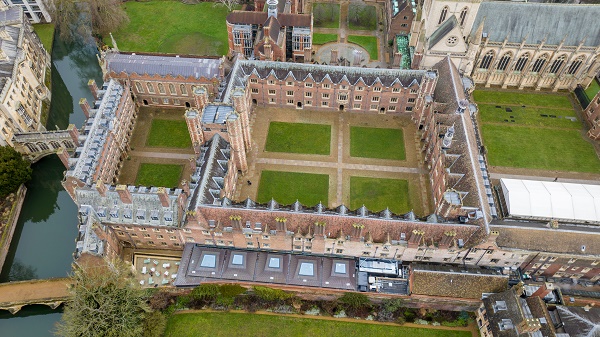
The Master said: “Opportunities to make transformational change to the beautiful and cherished architecture of St John’s are few and far between. On the rare occasions that we decide to intervene, it must be done with great care.
“This ambitious project is for a good cause and every aspect has been approached with imagination and sensitivity. We identified a pressing need for more and better communal space, responding to the ways we now prefer to work, eat, and socialise.”
"Opportunities to make transformational change to the beautiful architecture of St John’s are few and far between."
The goal of the carefully-planned transformation was to provide the community not only with a comfortable place to gather to eat and drink – at the heart of College life for centuries – but to answer newer calls for different kinds of work spaces, less formal than a library but less distracting or potentially isolating than a student room.
Architects Colin Moses and Paula Meija-Wright of MCW were set the task of meeting those demands in a contemporary style, while linking the facilities seamlessly to their distinctive – and carefully protected – historical context.
St John’s’ Grade I listed status requires specific and sensitive building standards, and a weekly four-hour inspection visit on behalf of Historic England – the body that protects listed buildings – ensured all requirements were being met. No significant archaeological discoveries were made on the site, but all original features uncovered, such as fireplaces and brick archways, were protected.
Creating the new facilities within the confines of the College and its working community created an array of challenges for the construction teams. Weight restrictions on the Kitchen Bridge limited access from that direction, and a height limit on the Queens’ Road entrance added further complications. Builders compressed their working hours to leave more quiet time for students, and exam schedules were pencilled in early to ensure noise temporarily stopped completely. Care was taken to make sure the construction work was made safe during the 2022 May Ball.
The College’s leadership was also determined from the outset to meet the highest sustainability requirements, despite the challenges of doing so on a site mixing historic fabric and newbuild elements. The project has achieved a coveted BREEAM Excellent rating: a world-leading sustainability assessment method for masterplanning projects and buildings. The building work, carried out by Ipswich-based Barnes Construction, has been completed in just 18 months, despite the challenges caused by the Covid-19 pandemic, which affected staffing and the supply of materials and equipment.
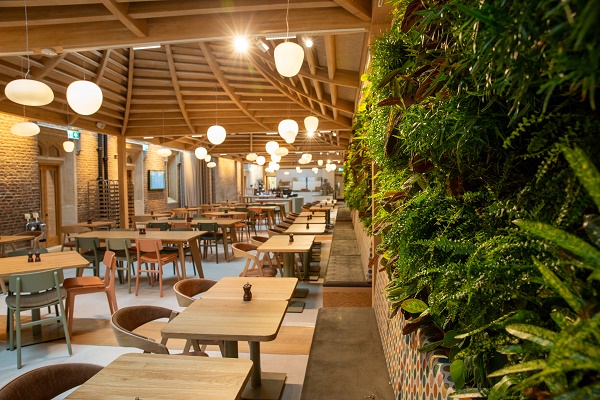
The Master said: “Creating beautiful new spaces that will nurture and enhance collegiality in the 21st century has meant adapting Grade I listed buildings, working on a constrained site, meeting very high environmental standards, delivering through a pandemic, and all the while enabling College life to carry on in all its intensity and variety. What an achievement, and what a stunning result, thanks to the extraordinary generosity of a single Johnian alumnus.”
She added: “Our architects at MCW have been a pleasure to work with over the last four years. With a wonderful lightness of touch, not least in the beautiful Buttery roof, their designs have responded with grace to the historic setting and will frame day-to-day life in the heart of the College for decades.”
"Creating the new facilities within the confines of the College and its working community created an array of challenges for the construction teams."
Once the architectural and building approach was confirmed, the same attention to detail was applied to the experience of everyone who will use the new spaces. The colour palette began with the use of St John’s distinctive blazer red in the Bar and, together with a deep green traditionally used across the College, was rolled out across the three interconnected spaces while giving each a distinct feel. Each area blends the historic and modern, from the Bar’s original panelling, to the fluted wood in the Café, and the Buttery brickwork and living wall. Furniture and finishes similarly convey the feeling of having ‘evolved’ over time.
Each facility has its own identity, emphasised by specially commissioned logos based on historic symbols seen throughout the College, which all have a heraldic link to our founder Lady Margaret Beaufort. The Bar is represented by a yale – a mythical ibex-like horned creature - while an eagle symbolises the Buttery and a marguerite daisy defines the Café. All three logos appear on new digital information screens displaying daily menus, and the branding carries through to take-away coffee cups and staff aprons.
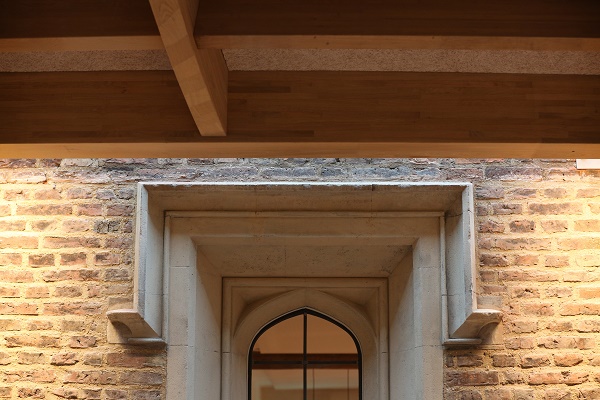
Further decorative touches deepen the links with the College’s rich past. The brass screen at the end of the bar is a modern interpretation of the forget-me-not motif – another symbol of Lady Margaret - and where possible ancient architectural details such as beams, panelling and the brickwork between the Café and Buttery have been left exposed. More recent history is honoured, too: on the café walls, eight new specially-commissioned photographic portraits of high-flying Johnian women celebrate 40 years of female students at the College.
"Each area blends the historic and modern, from the Bar’s original panelling, to the fluted wood in the Café, and the Buttery brickwork and living wall."
The new Bar has deliberately been given a more open and inclusive atmosphere than the original, but the U-shaped window seating from the former site has been retained and repurposed, and the new benches, like the old, are a distinctive red. A trophy cabinet is filled with silverware and the walls feature photographs of sporting achievements and other aspects of College life. Blinds covering the bar area during closed hours feature an original design created by second year History student Isabella Bottle, incorporating abstracted architectural elements of the Bridge of Sighs.
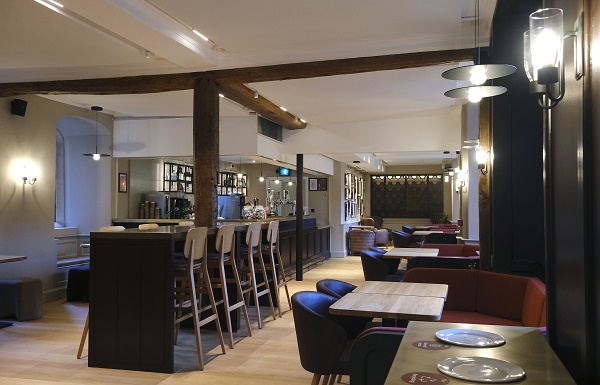
The facilities offer a range of delicious, affordable meals and snacks to suits the heartiest and healthiest of appetites and meet a range of dietary needs. The Café, on the site of the old Bar, sells a range of coffees made with a range of milks and ‘orangutan’ coffee supplied by UCC. The single origin beans come from Sumatra, and a share of the firm’s profits funds primate habitat conservation.
"The facilities offer a range of delicious, affordable meals and snacks to suits the heartiest and healthiest of appetites and meet a range of dietary needs."
The Buttery, open for lunch and dinner every day, is a light and airy space boasting a feature ‘green wall’ watered by rainwater from the top-lit, freestanding, oak-framed roof. Five vaulted, glass-topped ‘pavilions’ rise above the café-style tables, and doors at the western end of the room open out into a revamped and accessible terrace with new tables and chairs, in-built seating, and garden planting. Grade I-Listed gate piers have been carefully relocated in line with Kitchen Lane and Kitchen Bridge to create a new gateway to the area, and views from the terrace stretch across Kitchen Bridge over the River Cam and down to the Backs of the College beyond.
The Bar is open daily for drinks and bar snacks. In due course, a wider range will be introduced, including cocktails and a selection of freshly prepared bar food.
The Master, who officially opened the new spaces, predicted that the new Buttery, Bar and the Café would be “widely admired and wildly popular”.
She added: “This is the most beautiful and inspiring environment for learning, living and connecting. This bright, warm and welcoming space will enhance and enliven everyday life in John’s, in the best possible ways.”
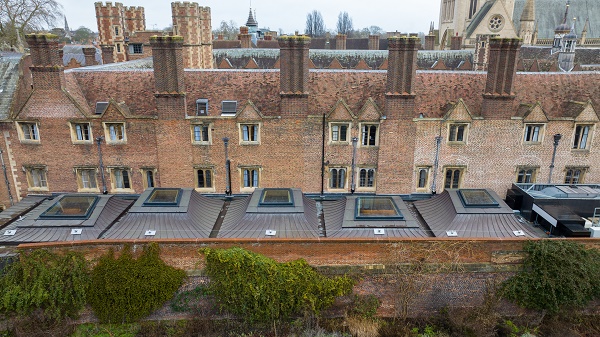
Published 30/01/2023